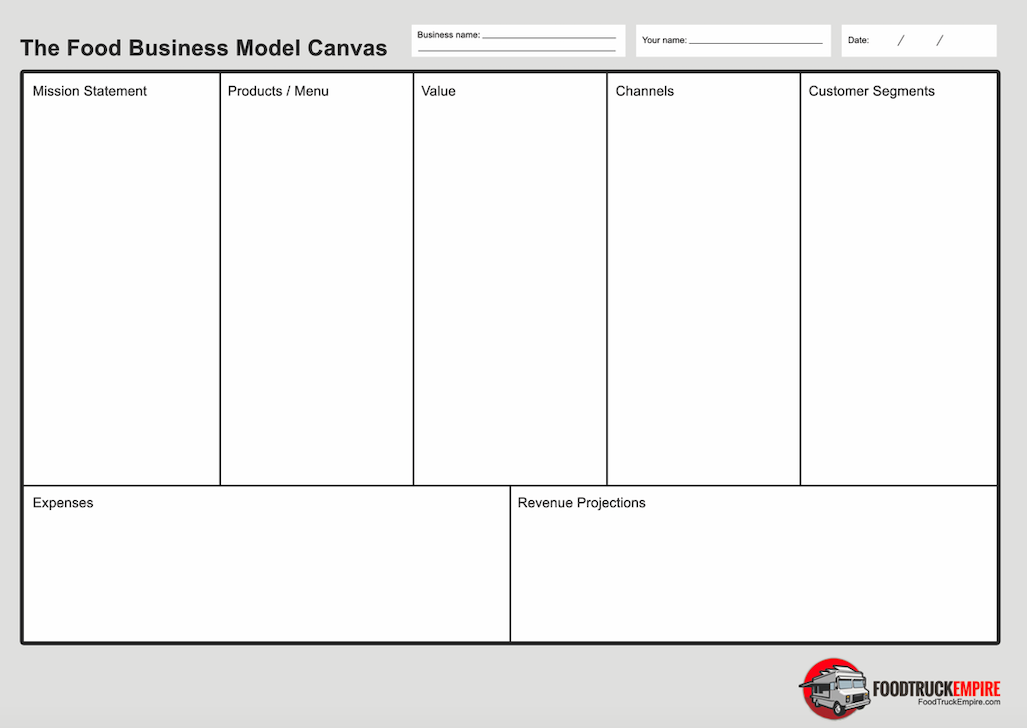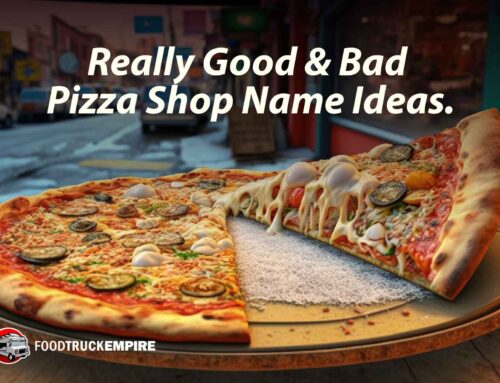It’s the age-old question haunting every small entrepreneur, who can’t get their concept for the next great small restaurant in their neighborhood out of their heads. You’ve got the idea. You’ve picked out a name. Maybe you’ve even been daydreaming about logo ideas and menu designs. But sooner or later, you need to be able to start assigning some hard and fast numbers to your ideas. In other words, you’ll need to figure out how much it will cost to open?
I opened a restaurant last year and am acutely aware of the laundry list of expenses that accompanies starting even a small, take-out focused restaurant like mine. All in, it cost me $8,000 to get the open the doors to Ancho Honey in Tenant’s Harbor, Maine. And yes, you read that figure right. I invested less than $10,000 to open the doors to the restaurant below.

Come see us in Tenant’s Harbor!
You probably won’t be able to open a business for that small of an investment. I live in a tiny fishing village in coastal Maine and found a location that was pretty turnkey. The rents here are also extremely low too. I live in a coastal town that is extremely busy in the summer months due to tourism, but only locals during the long winters.
I should point out that I put in more than a fair share of sweat equity to get this business off the ground. I called in literally every favor I could to help get my external sign made, painting walls, and getting door resized. To reduce startup costs, you’ll want beg for help from friends and family too.
One of the biggest expenses can is contracting out paid labor. You’ll need to hire out some aspects like plumbing and electrical to the professionals. But things like a new coat of paint, you can probably figure out on your own.
Ahh.. But you’re probably here to estimate the cost of opening your own restaurant, not read my personal story. I’ve added details about the main costs associated with opening an ma-and-pa restaurant below, including the wildly variable costs to consider. If you simply want to download the cost analysis spreadsheet so you can get busy figuring your own numbers, you can jump straight to that section below.
Let’s begin by organizing our expenses into two main categories: One-time costs, and recurring or ongoing expenses.
One-Time Costs
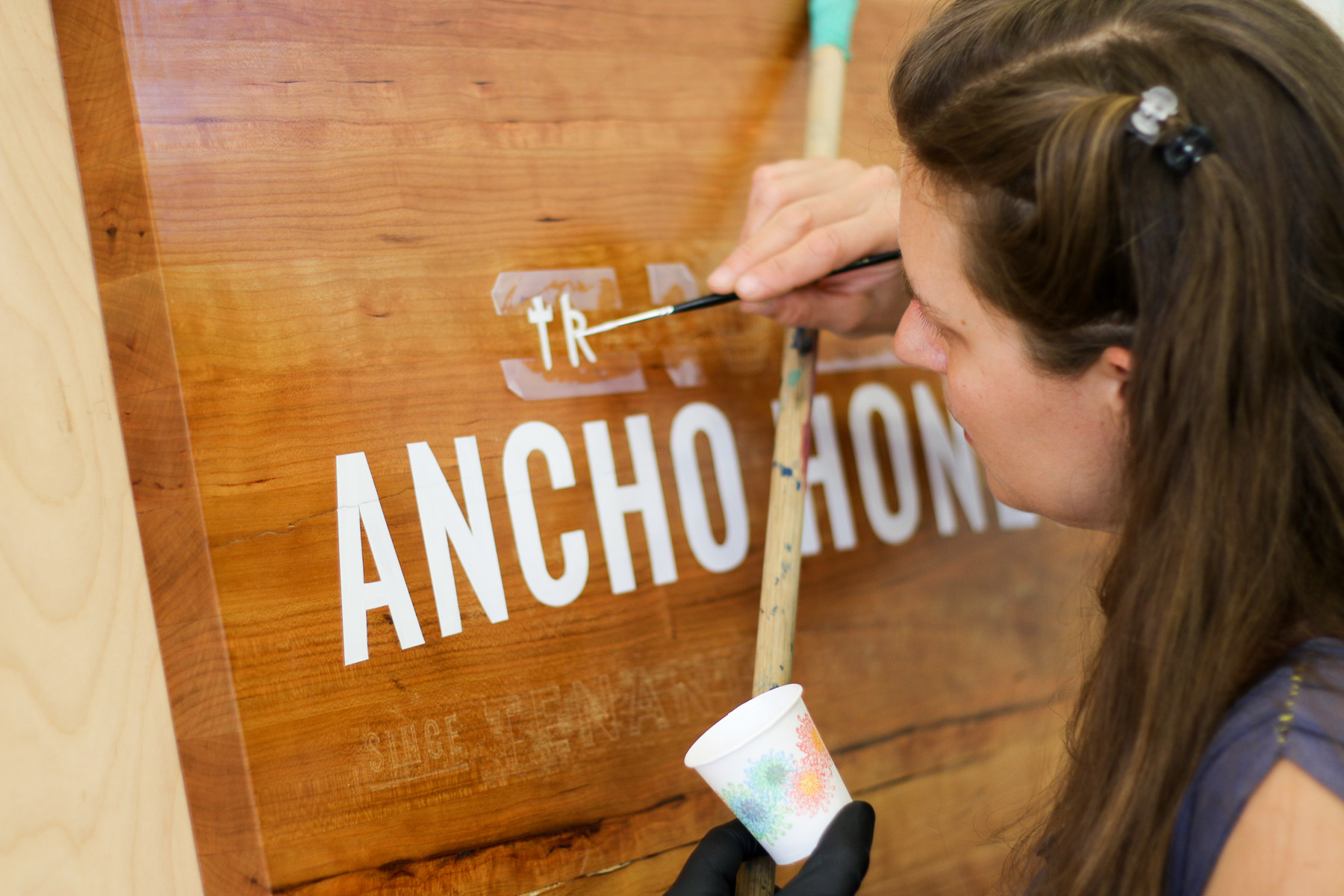
Painting the sign for Ancho Honey.
These costs represent one-time expenses that you’ll need to expect to pay when you’re getting started, which may not necessarily arise again in the life of your business. Obviously, there are some caveats here; for example, spending 10k on a commercial kitchen range may seem like a one time cost, but as the years wear on, it may need to be replaced. Plates break, silverware gets thrown away, and table linens get soiled; these are all technically one-time costs needed for getting the doors open, but which may come up again at some point in the future.
First/Last Month’s Rent and Security Deposit. The amount of money you’ll need to come up with may vary slightly depending on where you live, and some brokers or landlords describe these costs differently; some may refer to “first, last, and security,” while others may ask for the first month’s rent plus a security deposit equal to one or two month’s rent, which is refundable at the end of your lease term, provided the space is undamaged. For most commercial tenants, the total amount you’ll need to come up with will range from $3,000 to $30,000, and that’s just to get the keys.
Business Licensing and Permits. Again, this will vary depending on the location and type of establishment you want to open, and may be based on additional factors including whether or not you plan to serve alcohol, your hours of operation, and your location. In general, you should plan on obtaining city and state operating licenses, a food handler’s safety license (such as those offered by ServSafe), and a liquor license. Schedule a call with the health inspector and code enforcement officer in the municipality you plan to open, to find out more about specific requirements. In general, you should plan to budget between $100 and $1000 to get all of your paperwork in order.
Examples:
| Liquor license |
| Health inspection |
| Victualer’s license |
| Business permit |
| Dumpster fees/permits |
|
City level business registration fees
|
Insurance. You’re diving into a high-risk business, with a lot of potential for people getting hurt (or at least, claiming to). In addition to the inherent risk of selling a product that customers put into their bodies, you’ve got a whole host of additional general liability concerns: Slip and falls on freshly-mopped floors, or a broken wrist on an unshoveled snowy driveway can shut your business down in a hurry.
You’ll want a good general liability policy, to protect yourself and your business in the event of a customer complaint, and unlike renter’s insurance or other personal policies, most commercial policies need to be paid up front in a lump sum. Your quote will vary slightly based on the number of seats in your restaurant, your alcohol policy, and the type of food you serve, but you should budget between $1,000 and $2,000 for insurance.
Examples:
| General liability |
| Worker’s comp |
| Renter’s insurance |
Download Now: The Food Business Startup Kit is Free and Includes a Business Model Canvas.
Improvements and Remodeling. A big part of transforming a leased commercial space into the restaurant of your dreams lies in rennovations and remodeling. Unfortunately, this can be a very difficult number to pin down, since it will depend largely on the condition of the space you are renting (does it just need a coat of paint, or will walls need to be torn down and removed?), and the extent to which you’ll be overhauling the kitchen.
Remodeling Examples:
| Painting |
| Electrical work |
| Structural changes |
| Façade embellishment |
| Handicap accessibility |
| Plumbing upgrades |
| Interior design elements |

Me… Thinking about restaurant expenses.
In most cases, it’s possible to spend literally as much or as little money as you have on hand on these types of improvements. At the low end of the scale, you should earmark $10,000 for a building that’s already in usable condition, but which needs just a few tweaks, up to $250,000 or more for a complete overhaul, or say, converting an old Dairy Queen into to an authentic 11th century Chinese pagoda complete with animatronic fire-breathing dragons.
Cooking and Kitchen Equipment. This is another area where it’s possible to spend nearly limitless amounts of money, with a few different factors to consider: Does your leased space come with a kitchen, and are you comfortable with buying used equipment, or making due with what you have until cash flow improves?
Pro tip. One way to save a lot of money on startup costs is to purchase used restaurant equipment. Whether you’re looking for tables, chairs, or ovens it’s likely you can find gently used equipment for 50% or more than what you would buy something brand new.
Or are you building an kitchen from scratch, with brand-new appliances, refrigeration, ventilation, and fire suppression? You may be able to spend as little as $3,000 on a few odds and ends in the kitchen (such as new shelving, or a piece or two of used equipment), all the way up to $150,000 or more for a from-scratch build.
Examples:
| Range |
| Refrigeration |
| Fryers |
| Charbroilers |
| Walk in coolers |
| Freezers |
| Sinks |
| Dishwashers |
| Kitchen cutlery |
| Kitchen storage items |
Tables, Chairs, Plates, and Silverware. This is an area where many small entrepreneurs fail to budget enough money for their new restaurant. All of these items add up quickly, especially when you consider that you’re probably going to need multiple sets of each item, and you’re probably not going to want your customers sitting in plastic furniture with a soft drink logo on the back. You’ll need somewhere between $5,000 and $75,000 to outfit your restaurant’s front-of-house.
Examples:
| Tables |
| Chairs |
| Plates |
| Silverware |
| Napkins |
| Steak knives |
| Tablecloths |
| Chair covers |
| Misc linens |
Point of Sale Systems: You’ll need to be able to take orders, accept credit card payments, and make change, so you’re going to need a quality Point of Sale (or POS) system. Solutions for this part of your business can vary; we’ve seen successful restaurants launched on nothing more than an iPhone with a $20 Square magstripe card reader attached, all the way up to sophisticated order and inventory management systems with multiple screens, cash drawers, ticket printers, and barcode scanners for closer to $20,000.
Examples:
| Proprietary POS |
| iPad |
| Cash drawer |
| Receipt printer |
| Kitchen ticket printer |
| Barcode reader |
| Touchless payment reader |
Signage and Advertising: Launching a new business and winning the hearts and minds of your new customers can be an expensive proposition. Factor in the cost for logo design, some quality exterior signage, as well as an advertising campaign to promote your new business. You can expect to spend somewhere between $3,000 and $10,000, to make the biggest possible splash when you open your doors.
Examples:
| Awnings |
| Exterior signs |
| Window decals |
| Advertising agency |
| Letterhead |
| Business cards |
| Website |
| Newspaper ads |
| Social media placements |
| Radio ads |
Recurring and Operational Costs
Phew! Just when you think the cash hemorrhage is done, you remember: You’ve got to actually continue running your business, day-to-day, and month-to-month. Here are the main areas you’ll be spending your hard-earned dollars each month:
Lease Payments. This may be the most obvious part of your monthly overhead, and it’s also one of the most important; after all, a missed rent payment could violate your lease, and close your doors quickly, no matter how good your cashflow may be. Depending on the space you’ve rented and where you live, you’ll need to budget somewhere between $1,000 and $10,000 for your monthly rent.
Employee Salaries. What happens when you can’t make payroll? Your quality employees stop showing up for work, and your business starts its freefall into bankruptcy. Of course, the cost to keep employees happy will vary, based on where your business is located, and how much staff you maintain. If you’ll be performing General Manager duties, you’ll still need a head chef ($4,000-$8,000 per month), an average of $2,400 each month per line cook and prep cook, and $1,600 per month per server or hostess.
In addition, depending on which state you live in, you may be responsible for payroll tax and worker’s compensation insurance for each employee, which can add to your staff costs considerably. Total cost? Somewhere between $8,000 per month for a barebones, skeleton-crew staff, and $80,000 per month for a well-oiled team of professional food-slingers.
Food and Alcohol Costs. This will also vary, depending on the type of establishment you plan to open, and whether or not you plan to serve alcohol. Remember that food cost should amount to no more than 33% of your total sales, and can range from a few thousand to hundreds of thousands of dollars each month, depending on the size, volume, and type of food you serve.
Electricity, Propane, Internet. Until “eating in total darkness” becomes the next hot trend in restaurants, you’ll need to keep the lights on, the stoves running, and the refrigerators cooling. Depending on the size of your restaurant and the type and amount of equipment you have, you can expect to spend between $500 and $2,500 per month on these vital utilities.
Marketing and Advertising. If you hire a marketing or advertising firm to manage your media presence, expect to spend $500 or more for this service. For many startups, a focus on (free!) social media efforts including Facebook and Instagram can be sufficient to get the doors open, but if you expect to manage several print media placements, issue press releases, or any of the more traditional methods of marketing, hiring an experienced advertising or marketing firm may be in order.
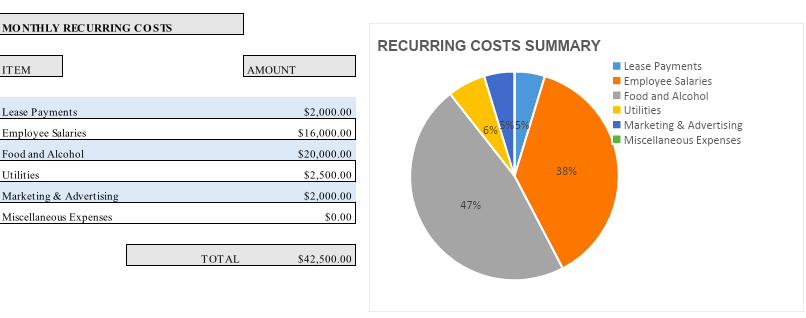
Estimate the monthly recurring costs to run your restaurant.
Insurance, Licenses, and Permits. Remember when we spent all of that money way back in the first section on insurance and permits? Well, they’re renewable every year. Keep a spare $1,000 or more in the budget to handle these renewals.
Miscellaneous Expenses. You get a frantic call at 3 in the morning from one of your line cooks, who walked into the walk-in refrigerator to find the compressor blown and all of your inventory sitting at a bacteria-friendly 75 degrees.
Your dishwasher explodes, spilling water through your rotten, mold-filled subfloor and flooding the basement. Your best server disappears for three days after her boyfriend gets released from prison. In the restaurant businesses, these types of crises arise all too often, and usually at a time when you’re just settling into a financial groove and feel like all is going well.
You’ll need to earmark part of your monthly budget for handling these unexpected emergencies; this number will be different for everyone, and depends a lot on your overall tolerance for risk, but setting aside 5% of your monthly revenue is a good place to start.
Variable Costs
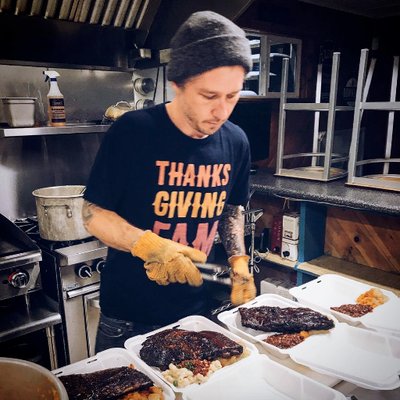
Plating some to-go meals.
No matter how great your idea may be, and no matter how big a hole there is in the marketplace just waiting to be filled by your restaurant concept, it’s impossible to figure out if it’s something you’ll be able to pull off, without some ballpark estimates of the cost of getting your new venture off the ground.
Unfortunately, in the restaurant industry, “ballpark” is often the best you can do, since your actual costs will vary wildly depending on where you plan to open your business (do you live in an urban area with high overhead costs, or a small town with more affordable rents?), the size and scale of your business (are you going to seat 10 people, or 100?), the size of your staff (will you be running with just a server or two, or will you need a full staff of hostesses, dishwashers, and line cooks?), and the style of food you plan to serve (are you opening a burger joint, or a bone-marrow-and-foie-gras uber-bistro?)
In an effort to shape the conversation and give you some hard figures to keep in mind as you are planning your new restaurant, we’re going to detail every factor that startup restaurant entrepreneurs should consider, along with a range of costs for each element. In order to do this, we’re going to make a few assumptions.
At the low end of the pricing estimate scale, we’re assuming that you’re opening a modest small restaurant with 6-10 tables, a minimal staff, simple furnishing and service items, in a rural or suburban area.
At the high end of the scale, we’re assuming that you’re opening a larger restaurant, with greater staffing needs, higher rent and overhead (as in urban areas), 100 seats, and higher-end cuisine. Most businesses will fall somewhere in the middle of this scale; it’s up to you to use these figures as a baseline for budgeting, planning, and potentially seeking investors for your particular concept.
For our purposes, we’re also going to assume that you are leasing or renting a commercial property; anyone interested in purchasing real estate to launch their new restaurant will have a few additional considerations.
Using Our Restaurant Startup Cost Spreadsheet
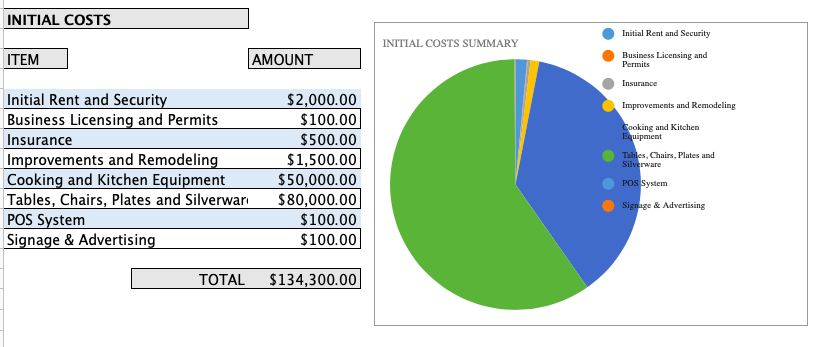
Estimate the startup cost of a restaurant with this worksheet.
Does this seem like a lot to keep track of? It is. Fortunately, we’ve made getting your startup cost estimates in order a little easier, with our free Restaurant Startup Cost Spreadsheet. Here’s how to use it:
- Click here to download our restaurant costs worksheet in Excel.
- You can also copy and view the document in Google Spreadsheets
- Add or remove rows or columns, depending on what applies to your unique business.
- Plug in your numbers, making estimates where necessary, and see a breakdown of both your initial and ongoing expenses.
After you download the attached documents you’ll notice two separate tabs. The first tab is called Worksheet. Here is where you will enter your high-level expenses at a category level. You’ll see your costs broken out by category in a pie chart.
The second tab is called Examples and lists specific examples of costs that fall into each category. The more detail and time you invest into determining what equipment you’ll need to get started the more accurate and helpful the document will be.
At the end of the day, no two restaurants will cost the same to startup. The total cost will depend on location, size, employees hired, kitchen equipment, and how much of the work you’re able to do yourself. My hope is this spreadsheet will help you determine some ball-park numbers for your startup.
By the way, if you’re planning to start a restaurant be sure to check out this Food Business Model Canvas template. This is a way to brainstorm the viability of your business in under 30 minutes.

